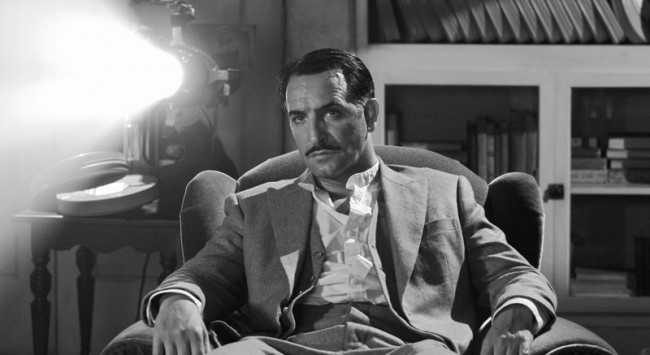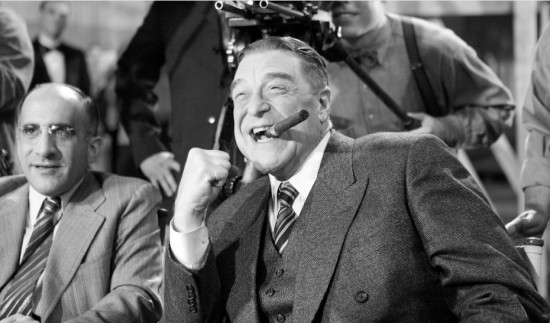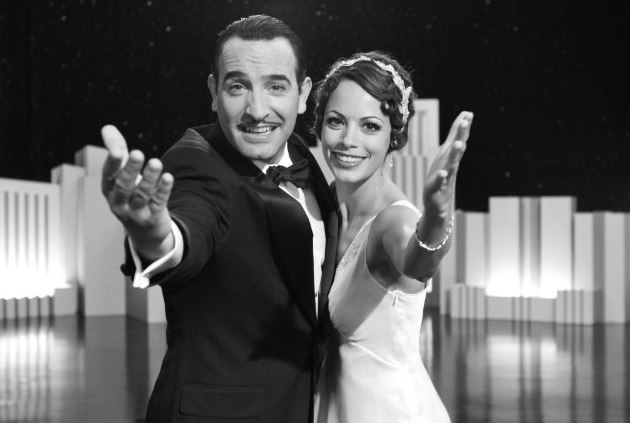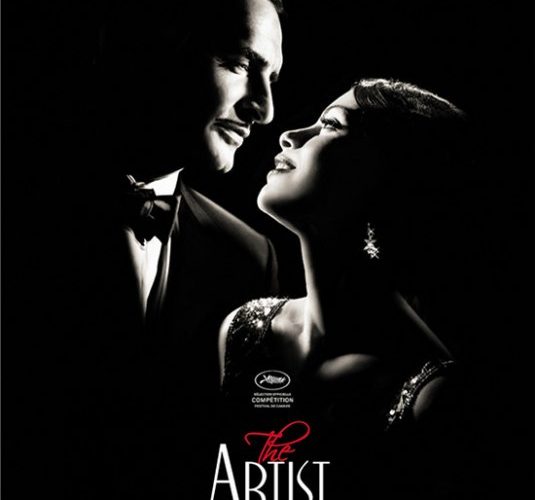
With the current generation of film goers awash with movies splattered with special effects, artificial 3D processing and endless computer generated images, it’s likely many are unfamiliar with the style of films that started it all. Of course, I’m referring to silent cinema, a lost art form that was treasured at the beginning of the last century when the emerging film camera technology was in its infancy. It was a time when people went to the theater, they were greeted with live music to accompany the silent images projected on screen. A true silent film hasn’t been made in nearly 80 years, since the advent of sound, but all that has changed at this years Cannes film festival. In Michel Hazanavicius‘ ambitious narrative experiment The Artist, the French director astutely recreates the subtle details of the lost era to make a joyous narrative that in itself is an allegory of how the movie industry has changed.
 The time is 1927, the setting is the burgeoning studio culture of Hollywood and the star is George Valentin, played with effervescent charm by Jean Dujardin, who is one of the most successful silent movie stars in this alternate historical timeline. The film opens with a throwback to Fritz Lang‘s Spies, as Valentin eats up the success of his latest film at it’s premiere. The crowd loves his silly antics along with the brilliant tricks of his trusted sidekick dog while overshadowing his co-stars. On his way out of the theater, he encounters a stunning young woman Peppy Miller, played by the beautiful Bérénice Bejo, who after attempting to get an autograph, shares Valentin’s spotlight in front of the paparazzi. This leads to a budding romance between the two but not without its own obstacles.
The time is 1927, the setting is the burgeoning studio culture of Hollywood and the star is George Valentin, played with effervescent charm by Jean Dujardin, who is one of the most successful silent movie stars in this alternate historical timeline. The film opens with a throwback to Fritz Lang‘s Spies, as Valentin eats up the success of his latest film at it’s premiere. The crowd loves his silly antics along with the brilliant tricks of his trusted sidekick dog while overshadowing his co-stars. On his way out of the theater, he encounters a stunning young woman Peppy Miller, played by the beautiful Bérénice Bejo, who after attempting to get an autograph, shares Valentin’s spotlight in front of the paparazzi. This leads to a budding romance between the two but not without its own obstacles.
 As the times are changing, so is the industry and with the emergence of ‘talkie’ pictures Valentin suddenly becomes a relic of the past. Valentin is quick to shrug off the new auditory element as a gimmick sparking the ire of those in charge. As the studio head looks to replace him with fresh meat, Peppy Miller rises to the occasion, becoming the new talk of town. The physicality both performers bring to their roles is magnificent and instantly evokes the stylings of classic Hollywood performers. Hazanavicius, whose best known for subverting the 60s spy films genre with his set of droll OSS films (also starring Dujardin and Bejo), is meticulous when it comes to detail, and each frame tells it’s own unique tale as it has to. Without being able to rely on the power of sound, despite a tremendously mood appropriate score, the filmmaker and actors are still able to dazzle in The Artist by fully realizing the joy of what made those classic silent films just that in the first place.
As the times are changing, so is the industry and with the emergence of ‘talkie’ pictures Valentin suddenly becomes a relic of the past. Valentin is quick to shrug off the new auditory element as a gimmick sparking the ire of those in charge. As the studio head looks to replace him with fresh meat, Peppy Miller rises to the occasion, becoming the new talk of town. The physicality both performers bring to their roles is magnificent and instantly evokes the stylings of classic Hollywood performers. Hazanavicius, whose best known for subverting the 60s spy films genre with his set of droll OSS films (also starring Dujardin and Bejo), is meticulous when it comes to detail, and each frame tells it’s own unique tale as it has to. Without being able to rely on the power of sound, despite a tremendously mood appropriate score, the filmmaker and actors are still able to dazzle in The Artist by fully realizing the joy of what made those classic silent films just that in the first place.
It’s amazing that in this day and age, and in an industry dominated by big budget and special effects, that a film like The Artist can disarm viewers with its overflowing charm. Both Bejo and Dujardin bring energy and life to their characters without ever having the chance to a mutter a word, and are more fully developed than those stemming from the mainstream films Hollywood continues to churn out. There are small moments that resonate as brilliance in their delivery, such as a nightmare scene Valentin experiences, filled with sound. Hazanavicius took a big risk in trying to make this dream project a reality, but the results are spectacular. Even if you are not a fan of the silent film era, The Artist has a lot to offer viewers willing to go down memory lane, due to the brilliant execution.
The Artist will see a late 2011 release via The Weinstein Company.

